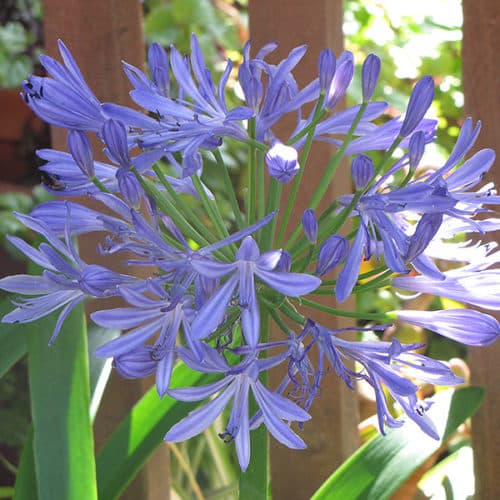Spectacular Agapanthus: Enhancing Your Garden's Beauty
Spectacular Agapanthus: Enhancing Your Garden's Beauty
Blog Article
Mastering the Art of Agapanthus Treatment: Crucial Steps for Healthy And Balanced Growth and Vivid Flowers
In the world of cultivation, the cultivation of agapanthus stands as a rewarding undertaking for those who seek to nurture these stylish blooming plants. With their striking blooms and elegant vegetation, agapanthus has actually recorded the focus of garden enthusiasts worldwide. However, achieving optimum development and vibrant blooms needs a nuanced method that includes numerous essential steps. From picking the appropriate variety to understanding trimming methods, the trip in the direction of growing thriving agapanthus plants is multifaceted and holds the essential to unlocking the full possibility of these botanical treasures.

Picking the Right Agapanthus Range

When picking the ideal Agapanthus variety for your yard, think about factors such as climate suitability, bloom shade, and development practice. Agapanthus, commonly known as Lily of the Nile or African lily, is available in a variety of colors ranging from tones of purple and blue to white. Choose a flower shade that enhances your existing garden palette to create a harmonious landscape. Furthermore, consider the environment in your area to ensure the Agapanthus range you choose can prosper in your specific problems. Some varieties are a lot more tolerant of cool temperature levels, while others favor warmer climates. Comprehending the development behavior of various Agapanthus varieties is essential for correct positioning within your garden. Some ranges have a clumping growth behavior, ideal for containers or borders, while others have an even more dispersing nature, appropriate for ground cover or mass growings. By very carefully examining these factors, you can select the ideal Agapanthus variety to enhance the beauty of your yard.
Ideal Planting Problems
Taking into consideration the optimum environmental demands is important for effective Agapanthus farming. Agapanthus plants are delicate to chilly temperatures and must be shielded from frost throughout winter months.
To ensure healthy and balanced growth and vivid blooms, plant Agapanthus bulbs at a depth of concerning 2-4 inches and area them 8-12 inches apart. Including organic matter, such as compost, to the dirt can improve drainage and fertility, promoting durable root advancement. Mulching around the base of the plants assists maintain moisture and suppresses weed growth. Normal watering is crucial, particularly throughout the expanding period, to keep the soil continually wet however not saturated.
Watering and Fertilizing Tips
Keeping correct dampness levels and offering important nutrients are key aspects in the care regimen for Agapanthus plants. When it comes to sprinkling Agapanthus, it is critical to strike a balance. These plants prefer regularly wet soil yet are susceptible to root rot if overwatered.
Feeding Agapanthus is vital for promoting healthy development and respected blossoms. Apply a balanced plant food, such as a 10-10-10 formula, in the early spring as brand-new growth arises. By adhering to these watering and fertilizing tips, you can guarantee your Agapanthus plants grow and generate vibrant, durable flowers.
Trimming Strategies for Agapanthus
Trimming Agapanthus plants at the suitable times and with appropriate strategies is important for preserving their wellness and advertising optimal growth and flowering. The ideal time to prune Agapanthus remains in late winter or early spring before brand-new growth arises. Start by removing any dead or yellowing leaves near the look at here now base of the plant. Cut them as close to the ground as feasible without harming the emerging shoots.
Deadheading spent flowers can also redirect the plant's energy right into generating more flowers instead than establishing seeds. If you want to collect seeds for propagation, leave some blossoms to dry and mature on the plant.
Bear in mind to utilize clean, sharp tools to make accurate cuts and decrease the risk of presenting diseases. Agapanthus. Normal pruning will certainly help keep your Agapanthus looking healthy and neat while ensuring an abundant display screen of lovely flowers
Handling Common Pests and Diseases
After making certain appropriate trimming strategies for Agapanthus, it is crucial to attend to common pests and diseases that can influence the health and wellness and vigor of these plants. One usual bug that influences Agapanthus is the Agapanthus gall midget.
An additional common issue is fungal leaf place, which provides as dark lesions on the fallen leaves. To stop fungal illness, guarantee good air blood circulation around the plants, stay clear of overhanging watering, and eliminate any contaminated leaves without delay. Additionally, Agapanthus plants can endure from root rot if they are planted in poorly draining dirt. To stop this, plant Agapanthus in well-draining soil and avoid overwatering. By being watchful and taking prompt action against pests and diseases, you can aid your Agapanthus plants prosper and create lively blooms.

Final Thought
Finally, grasping the art of agapanthus treatment entails selecting the appropriate selection, giving perfect planting conditions, correct watering and feeding, appropriate pruning techniques, and attending to typical pests and diseases. By complying with these essential actions, you can my review here make sure healthy development and dynamic blossoms for your agapanthus plants. Keep in mind to consistently keep an eye on and preserve your plants to advertise their total wellness and longevity.
To ensure healthy development and vivid blossoms, plant Agapanthus light bulbs at a deepness of regarding 2-4 inches and area them 8-12 inches apart. By following these watering and fertilizing tips, you can ensure your Agapanthus plants flourish and generate lively, durable blossoms.
One typical bug that affects Agapanthus is the Agapanthus gall midget. In addition, Look At This Agapanthus plants can suffer from root rot if they are grown in improperly draining soil. By adhering to these necessary actions, you can make sure healthy and balanced growth and dynamic blossoms for your agapanthus plants.
Report this page